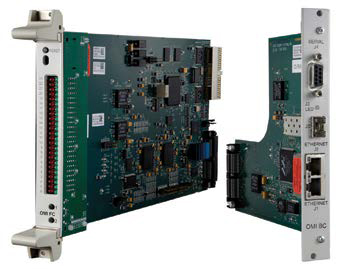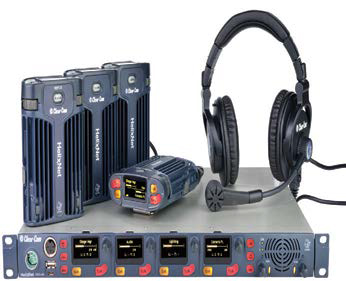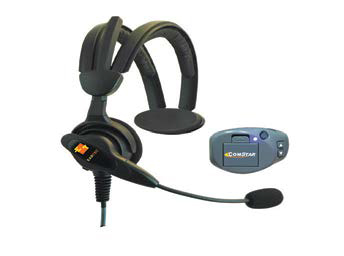Intercoms Ramp Up for Bigger Events

RTS Adam Omneo interface cards transform the RTS Adam intercom system into a flexible, IPbased, AVB-compatible intercom network.
SEATTLE—Intercom systems to communicate among members of a television production crew have been around since television began, and remain a necessity. What’s different about today’s intercoms are the size of productions that must be served (think of the Olympics) and the latest digital and network technology.
The analog party line system of the 1960s, where everybody on the intercom system was on the same channel and separate wires had to be run to each station, is becoming a thing of the past. “Analog party line has been servicing us well,” said Vinnie Macri, product marketing manager for Clear-Com. “But productions have been growing bigger and bigger, not only televised sports and news, but in theater and entertainment venues as well.”
LESS WIRING
Clear-Com’s HelixNet digital intercom system is networkable, and up to 12 channels of intercom can be put on one cable, according to Macri. Any beltpack or base station on HelixNet can be configured to receive any channel on the intercom system without running extra cabling. And in place of 2-channel capable beltpacks and base stations, Clear-Com now has 4-channel units.
Reducing the amount of intercom cabling is no small thing to a remote production, where every piece of wire costs money as well as manpower to deploy ahead of the event and to coil and stow when the production is done.

Clear-Com’s HelixNet digital intercom system Macri said HelixNet has made it increasingly possible to interface with other communication systems. “You can interface to such things as walkie-talkies, telephones, to big matrix intercom system, to satellites, to whatever you need to communicate on.”
OPEN STANDARDS
It often is necessary to combine two different brands of intercom systems together when, for example, a mobile truck, with brand X intercom installed, rolls up to a stadium or other venue wired with brand Y intercom. In response, RTS has developed Omneo, an open standard that allows third party interface development, according to Harry Klane, director of sales at RTS.
Get the TV Tech Newsletter
The professional video industry's #1 source for news, trends and product and tech information. Sign up below.
There are two parts to RTS’ open standard: Dante, which handles transport of audio over IP; and OCA, the control protocols that are transferred along the network.
Another challenge RTS has addressed in Omneo is latency, the delay between when a command is spoken into the system and when it’s heard at a particular beltpack or base station. “Typically over standard setups our latency is under three milliseconds, which is undetectable,” Klane said.
With the large installed base of RTS intercoms worldwide, Klane pointed to Omneo’s backward compatibility with legacy intercom equipment, and to Omneo’s “endless expandability, anywhere from two to 10,000 nodes,” as testament to the system’s versatility. “So we’re capable of handling really large systems that other people just really can’t handle,” he said.
At this year’s Super Bowl, where RTS intercom systems in New Jersey and New York City were connected via an IP network, Klane said the company got the ultimate compliment: “They all remarked how they felt the person they were talking to was in the room next to them.”
Audio quality was a major focus when Riedel Communications developed its Artist Digital Matrix Intercom, which is why they use digital AES3 audio throughout all of their systems, according to Sascha Kneider, head of technical services, North America. “[It’s used in] the panels, user stations, AES audio back and forth to the frame,” he said.
He pointed to two advantages to this. “One is that you have the full audio bandwidth, so that system goes beyond intercom quality, and can also be used for monitoring because it has the full broadcast audio bandwidth.
“The other is, since we’re not using analog audio to get back and forth with a separate data-stream—that would need proprietary cabling—you could take that digital AES audio and route it to existing systems, like through audio routers, or MADI streams, or even embedded through video.”
Artist can also utilize a fiber ring infrastructure that makes it easier to scale the system larger. “You can grow the matrix just by adding nodes on a fiber ring that collects through the CPU cards,” Kneider said.

Eartec Comstar Kneider also pointed to a soft-key on Riedel’s new base stations and beltpacks. “You can basically program any kind of functionality on that key.” He contrasts this with the competition, where “you would have fixed function keys or would even have to have a different piece of hardware to realize certain functionality.”
Eartec’s Comstar intercom is a full duplex standalone wireless intercom system capable of putting up to eight crew members on the same channel, or split them between two channels.
“It is open line, just like a telephone,” said Eartec General Manager Matt Champlin. “With most communications, it’s just one way, or voice-activated. This is full duplex, so it sends and receives the [communication] at the same time, just like a telephone. So there’s never any miscommunication, where somebody’s talking and you can’t get through.”
The headsets run for 10 hours on a charge. Champlin added that Eartec runs on a new frequency put out by the FCC at 1900 MHz. This frequency was put out for voice communications only and runs on a digitally enhanced signal.
ENTER THE SMARTPHONE
According to JK Audio President Joe Klinger, in recent years, the company started to hear requests to combine familiar intercom headsets with wireless communication through a smartphone. The result is the Outerloop Wireless Intercom Belt Pack, a universal beltpack that provides XLR connections for existing 4-pin or 5-pin intercom headsets, routing audio through a Bluetooth wireless connection to a mobile device where it connects to the intercom system over the cellular network to a phone bridge.
“The unit supports Bluetooth HD Voice, which is substantially better than a regular Bluetooth connection,” Klinger said. Smartphones like the iPhone 4, iPhone 5 and new Samsung phone all use the Bluetooth 7 kHz audio standard.
“The Outerloop beltpack has the same feel as traditional beltpacks, with the push-to- talk button,” Klinger said. “We did add a send level control, which you never see on a beltpack, a microphone level control. That’s to compensate for the differences with cellphones, not necessarily the mic in the headset. Whether you’re going into a laptop or a netbook, with Bluetooth the sensitivity varies substantially, and in order to get the best signal we felt it necessary to put a send control on there.”
Intercom systems remain a critical element to television production, and as technology allows intercom makers to improve their systems, we’re sure to see advances like these continue.
